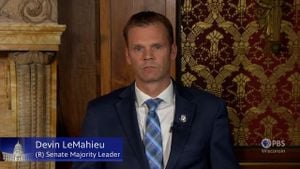Election Day 2024 dawned with high expectations and nerves across the United States, setting the stage for political drama. By nightfall, the early votes turned out results as surprising as they were significant. Former President Donald Trump emerged victorious against Vice President Kamala Harris, reclaiming the presidency he controversially lost four years ago. Early results indicated Republicans would also recapture control of the Senate, throwing the House of Representatives' fate still up for grabs. But the election was fraught with tension, as many key races remained too close to call well after the polling stations closed.
The political atmosphere was electric, especially with Trump's supporters rallying at his campaign headquarters in Palm Beach, Florida. "This is the moment we’ve all been waiting for. The forgotten America is coming back," he passionately told the crowd, echoing themes of nationalism and economic revival. Meanwhile, Harris conceded defeat with poise, stating, "We fought for our vision of America, but today the people have spoken." The remarks, though gracious, hint at undeniable disappointment as the Democratic Party assessed the ramifications of this unexpected loss.
Projected numbers reported by multiple sources indicated Trump’s lead right from the onset, with Republicans claiming significant victories across various battleground states. States like Florida and North Carolina saw solid support for Trump, where he retained the strong base he forged, especially among rural voters and those dissatisfied with the current economic climate. Analysts noted shifts were particularly perceptible among Latino men and working-class voters—demographics traditionally allied with Democrats.
On the Senate side, Republicans marked their territory, successfully flipping several Democrat-held seats. A standout race was Pennsylvania, where Republican businessman Dave McCormick managed to oust long-serving Democrat Senator Bob Casey, signaling possible fraying nerves within the Democratic leadership as they reconsider their strategies.
By Thursday morning, the House of Representatives echoed the uncertainty with several races still undecided. Republicans had claimed 209 seats, compared to the Democrats' 196, underscoring the possibility of another tightly contested chamber. Both parties were poised for any slip-ups, as the fight to reach the coveted 218 seats mark would determine who holds the majority. Republican House Speaker Mike Johnson made comments to fellow Republicans about feeling "the mandate" from voters, setting up expectations for sweeping legislative moves.
The stakes were high across various states such as Arizona, Nevada, and Pennsylvania, where votes poured in from election precincts and mail-in ballots. Arizona had garnered attention for showing Trump with the lead, yet ballot counting was hampered by extensive mailing processes. Nevada was proving tougher yet, with the race still seeming neck-and-neck.
California and New York emerged as key areas for potential Democratic gains, albeit against aggressive Republican attempts. Each race remained pivotal, with results trickling through, making analysts cautious about drawing conclusions too early. The decisions made by Democrats were closely watched, particularly on how they responded to the sudden shifts registered by voters and how they plan to retake their strongholds. Analysts underlined the importance of California, where several districts were too close to call, with the potential to swing either way impacting the Democrats’ chances to reclaim the House majority.
One significant event of the night hinged around Harris's presentation of her campaign focused on abortion rights and healthcare, issues drawing differing levels of engagement among voters. Incumbents began weighing their vulnerabilities openly on social media amid calls from constituents seeking clarity on future policies. Voter turnout was substantial but mixed, showcasing the divide felt within various communities. This sentiment was echoed by leadership at The Trevor Project, pointing out spikes in their crisis line as the LGBTQ community braced itself for uncertain futures with Trump's presidency.
Post-election fallout began immediately, triggering intense reflection within party circles. Biden's remarks about the transition underscored the Democrat's resolve, specifying they would “support a smooth transition” for the incoming Trump administration, fostering hope for bipartisan cooperation, albeit shakily.
Meanwhile, the atmosphere shifted drastically outside the polling booths with protestors forming across several cities, altering the narrative. Advocacy groups targeting LGBTQ+ rights, healthcare legislation, and abortion laws mobilized their base, cautioning against perceived rollbacks under Trump’s predicted administration. Analysts projected this showed how torn the electorate felt, highlighting frustrations expressed at local and national levels.
The economic environment added layers of complexity to the election narrative, as Trump pledged during the campaign to ease inflation and stimulate economic growth through tax cuts and deregulation. The Federal Reserve's recent moves to lower interest rates only added flair to his rhetoric, though many remained skeptical about real change.
Looking forward, the results raised questions about how Trump's return will impact policies particularly focused on education and healthcare reforms put forth by the Biden administration. With Biden's policies under immediate review, higher education reforms, including student loan forgiveness initiatives stood at risk of serious overhauls. This possibility sent waves through various academic communities attempting to bolster equity among students.
Where Democrats tread carefully, Republicans perceived pathways to cement their positions across various sectors. The clash between progressive ideals and conservative reactions catalyzed mixed feelings about future collaborations as both parties contemplate their paths back to acceptance among citizens. Conclusion and continued analysis are necessary, as the immediate future will likely shape the administration's agenda and affect the midterms.



